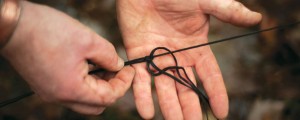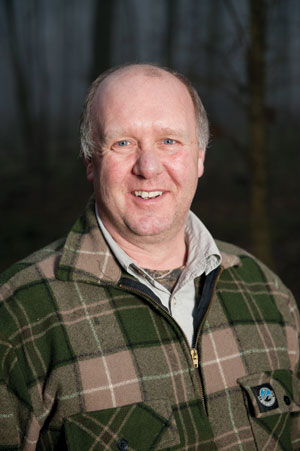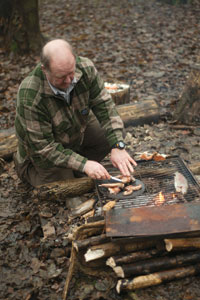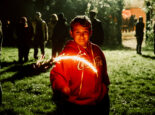Into the Wild


There’s a mug of gorse flower tea in my hand, I’m sitting on a log in ancient woodland waiting to take my first bite from a cut of grilled rabbit. The smoke from the fire fuses with the tantalising aroma of frying meat to form a giant wake-up call to my under-used city senses.
I watch mesmerised as the smoke blends seamlessly with the mist lingering around the trees and I find it hard to believe that I’m still less than 20 minutes away from Peterborough City Centre.
 I’m the latest victim of Fragile Earth and its owner, Andrew Shaw, a bushcraft expert who has been converting city slickers into outdoorsmen at his magical woodland retreat near Kings Cliffe for the past few years. Well, maybe magical is a little strong but there’s definitely something profound happening here. Thankfully, I’m not the only one who feels it and my companions for the day, my brother Doug and friend, Paul Franks both echo my sentiments. Andrew pipes in that he’s not a religious person but finds woodland spiritual in a way he can’t define. The feeling you get from this place is something you quickly forget while living in the city. Although the fact that our Blackberry devices have a limited signal out here probably contributes to the relaxing atmosphere.
I’m the latest victim of Fragile Earth and its owner, Andrew Shaw, a bushcraft expert who has been converting city slickers into outdoorsmen at his magical woodland retreat near Kings Cliffe for the past few years. Well, maybe magical is a little strong but there’s definitely something profound happening here. Thankfully, I’m not the only one who feels it and my companions for the day, my brother Doug and friend, Paul Franks both echo my sentiments. Andrew pipes in that he’s not a religious person but finds woodland spiritual in a way he can’t define. The feeling you get from this place is something you quickly forget while living in the city. Although the fact that our Blackberry devices have a limited signal out here probably contributes to the relaxing atmosphere.
Fragile Earth’s owner, Andrew Shaw has always had an interest in bushcraft and spent much of his childhood camping on the Moors around his home in Sheffield. He learnt to hunt and shoot and it was no surprise that he ended up as a professional hunter, deerstalking for the landowner of a 20,000 acre site in Scotland. After that, he got into mainstream pest control, focusing on wildlife management enabling him to spend most of his time in the countryside, learning and honing the skills he teaches today. Business finally settled him in Peterborough where he set up bushcraft training while working at a school in the city. It’s proved so popular, particularly with the city’s schools that running Fragile Earth has become his full time job since June 2008.
Having benefited from survival training in some of the UK’s harshest terrains, I’m sceptical about what this area can offer but am soon corrected by our host for the day. “The challenge of trying to do bushcraft in the Fens is a lot harder than somewhere you’ve got a big forested area, certainly if you are looking for shelter,” he tells me. “There are different challenges but there are different rewards too, including finding alternative foodstuffs while foraging.”
And with those words of wisdom ringing in our ears, we set about our first task – to get a fire going. You wouldn’t think that finding wood would be particularly difficult considering that we are in woodland, but the recent snow and frost has made everything wet and damp. Under Andrew’s expect guidance, we’ve soon got enough for a decent fire but the problem is going to be finding dry tinder – and creating a spark. Prepared for this, Andrew supplies some dry, paper-like bark and a Swedish fire steel – a clever tool which rains a shower of hot sparks over the tinder and a fire is soon going. The novelty of starting a proper campfire without using matches or a lighter will never wear off and it always amazes me that so many of my friends would struggle to know how to build a fire much less start one without a lighter or matches.
 Fire on the go, it’s time to make a shelter. On the more in-depth courses, Andrew teaches the art of shelter building using solely natural materials but this time we discover the benefits of a simple hammock and tarpaulin. “I prefer hammocks because they are more comfortable than lying on the hard, cold floor,” he tells us. “They have a minimal impact on the environment and are better than tents in many ways, which can easily damage plant life in the area. There are some downsides too, your sleeping bag can squash down and you end up with a cold back so I lie on a reindeer skin to stay warm, but you can always use a roll mat or Therm-a-rest if you are backpacking. Hammocks are ideal for uneven terrain, or staying out of boggy mud and you can even string them up using a tree and a vehicle if you need to.” Sounds like hammocks are the way forward to me although I’m not sure I’ll be adding reindeer skin to my shopping list just yet.
Fire on the go, it’s time to make a shelter. On the more in-depth courses, Andrew teaches the art of shelter building using solely natural materials but this time we discover the benefits of a simple hammock and tarpaulin. “I prefer hammocks because they are more comfortable than lying on the hard, cold floor,” he tells us. “They have a minimal impact on the environment and are better than tents in many ways, which can easily damage plant life in the area. There are some downsides too, your sleeping bag can squash down and you end up with a cold back so I lie on a reindeer skin to stay warm, but you can always use a roll mat or Therm-a-rest if you are backpacking. Hammocks are ideal for uneven terrain, or staying out of boggy mud and you can even string them up using a tree and a vehicle if you need to.” Sounds like hammocks are the way forward to me although I’m not sure I’ll be adding reindeer skin to my shopping list just yet.
It’s now mid-morning and we are British, so that can only mean one thing – time for a spot of tea. Andrew tells us that we’ll have to get water from the stream using a Millbank Bag, which is basically a canvas bag that filters the gunk out of the water and then we’ll purify it before we can brew up. As we head reluctantly toward the sound of running water, he calls us back and pulls out a bottle he already filled from home. Andrew runs a nice sideline in comedy too by the sound of it. As you would expect from an expert in wild living, he also has a wide selection of tea flavours available, ranging from the more familiar Yorkshire Tea bags to the colourful lime flower and gorse flower leaves. I can’t imagine any of the local cafes putting it on their menus any time soon but it hits the spot perfectly in the freezing, foggy woods today.
 The recently-thawed snow and heavy frosts haven’t been kind on the flora but we did manage to find a small amount of Jew’s Ear, the world’s most politically incorrect fungus; a mild mushroom popular in China. But picking mushrooms can be extremely dangerous as Andrew informs us. “The most important rule is not to pick any mushrooms unless you know for sure exactly what they are, as many varieties look very similar. I’ve limited myself to about ten varieties, where even if I pick a bad one out of that family, the worst I’ll get is a stomach ache. Another thing to be aware of is that mixing alcohol and certain freshly-picked mushrooms can make you very ill or even be fatal in some cases. The second most important rule is not to over-pick from one area – you need to leave some there to spore to ensure there are more for you to collect at a later date.” Sustainability is the key here and something that we’ve clearly lost touch with in the modern, civilised world.
The recently-thawed snow and heavy frosts haven’t been kind on the flora but we did manage to find a small amount of Jew’s Ear, the world’s most politically incorrect fungus; a mild mushroom popular in China. But picking mushrooms can be extremely dangerous as Andrew informs us. “The most important rule is not to pick any mushrooms unless you know for sure exactly what they are, as many varieties look very similar. I’ve limited myself to about ten varieties, where even if I pick a bad one out of that family, the worst I’ll get is a stomach ache. Another thing to be aware of is that mixing alcohol and certain freshly-picked mushrooms can make you very ill or even be fatal in some cases. The second most important rule is not to over-pick from one area – you need to leave some there to spore to ensure there are more for you to collect at a later date.” Sustainability is the key here and something that we’ve clearly lost touch with in the modern, civilised world.
Andrew opens a small bottle and says “Try this” as he pours a sticky liquid on my fingers. An explosion of sweet sugary treacle hits my tongue. “It’s birch syrup,” he tells me as I drift off all Homer Simpson-style, craving pancakes and waffles – it tastes like the most fantastic maple syrup you can imagine. “The thing is that it takes about 10 litres of sap just to make half a litre of syrup,” morns Andrew, “so it’s fairly precious and you have to be careful not to damage the trees in the process. I can get around two litres overnight from a tree and even then it takes another four hours to boil the whole lot down into this much syrup.” Considering maple syrup only costs a couple of quid in the supermarket, it seems like a lot of effort but it’s extremely pleasing just to know that you could do it if you had the time and inclination.
 When it comes to all-time, bushcraft clichés, whittling must run a close second to singing ‘Kumbayah’ around a campfire, but it’s far more useful, and with our combined voices, probably far more enjoyable too. A roll of razor-sharp knives and curved blades appears before us. It seems to me that they wouldn’t look out of place in a Spanish Inquisitor’s handbag. “Whittling anyone?” Andrew asks. I take a step back and volunteer my brother to have a go. After a health and safety briefing, Doug is soon whittling away to his heart’s content while Andrew subtly shuffles away to a safe distance. Luckily, Doug breaks the habit of a lifetime and doesn’t spill any blood – his, or anyone else’s for that matter. He seems proud of his work and thanks to a nudge from Andrew we soon realise it’s a rudimentary wooden spoon and that leads us perfectly onto lunchtime. In order to save time, Andrew has brought along a rabbit he caught earlier in the morning. Preparing it only takes a few quick cuts with a knife and a bit of brute force for someone as experienced as Andrew. With the fire still burning, out comes a frying pan badly in need of greasing before we can start cooking. Andrew nips back to the rabbit and pulls the right amount of fat from around its kidneys. It’s here that you really start to see the point of bushcraft skills. At home we’d have to nip to the supermarket to pick up some oil but here in the woods, nature can take care of you, once you start to get the idea.
When it comes to all-time, bushcraft clichés, whittling must run a close second to singing ‘Kumbayah’ around a campfire, but it’s far more useful, and with our combined voices, probably far more enjoyable too. A roll of razor-sharp knives and curved blades appears before us. It seems to me that they wouldn’t look out of place in a Spanish Inquisitor’s handbag. “Whittling anyone?” Andrew asks. I take a step back and volunteer my brother to have a go. After a health and safety briefing, Doug is soon whittling away to his heart’s content while Andrew subtly shuffles away to a safe distance. Luckily, Doug breaks the habit of a lifetime and doesn’t spill any blood – his, or anyone else’s for that matter. He seems proud of his work and thanks to a nudge from Andrew we soon realise it’s a rudimentary wooden spoon and that leads us perfectly onto lunchtime. In order to save time, Andrew has brought along a rabbit he caught earlier in the morning. Preparing it only takes a few quick cuts with a knife and a bit of brute force for someone as experienced as Andrew. With the fire still burning, out comes a frying pan badly in need of greasing before we can start cooking. Andrew nips back to the rabbit and pulls the right amount of fat from around its kidneys. It’s here that you really start to see the point of bushcraft skills. At home we’d have to nip to the supermarket to pick up some oil but here in the woods, nature can take care of you, once you start to get the idea.
As the scent of sizzling rabbit hits my nose it dawns on me how hungry I am now. I jokingly apologise for leaving the ‘Reggae Reggae’ sauce at home but Andrew tells me off for a different reason than I expect. “We are very different from a survival school,” he proclaims. “They are all about how to stay alive when the worst things happen, whereas our courses are all about how to enjoy nature and benefit from it. Bringing sauce from home is another way to make the outdoor experience more comfortable.” Fair enough, but perhaps I shouldn’t ask where the plates and cutlery are though. “You have to cook rabbit very fast or very slow,” says Andrew as I take my first bite of the tough game meat, “it’s best in stews with a load of vegetables.” He’s definitely not wrong and I’m left pondering the promise of ‘Reggae Reggae Rabbit’ next time.
As some people just don’t like the idea of eating fluffy mammals, Andrew has brought along a couple of rainbow trout too. He smiles cheekily as he opens the bundle from Sainsbury’s fish counter. “Some outdoorsy people think that the woodland should be nature’s supermarket, and it would if there were only a few thousand people in the UK. Unfortunately the woodland is now only a corner shop so we still have to go to a supermarket occasionally.”
 He sends us away to shave the bark off some green sticks to create a frame for cooking the trout, meanwhile, the fish is relieved of its head, fins and tail ready to be spread out and balanced high above the fire for cooking. As it cooks, fat drips off into the fire creating a trail of mouth-watering aromas around the wood, which serves as a homing beacon for Doug and Paul who are nearby collecting more firewood. There is something truly magical about cooking food like this, and probably why men naturally gravitate towards a barbeque; the combination of fire and raw meat definitely make us feel more like cavemen. Entertainment comes in the form of unanimous moans of despair as yet another piece of delicious fish accidentally falls into the fire. You can’t bear the thought of losing just one morsel and it certainly makes you think about how much we waste everyday in our modern way of life.
He sends us away to shave the bark off some green sticks to create a frame for cooking the trout, meanwhile, the fish is relieved of its head, fins and tail ready to be spread out and balanced high above the fire for cooking. As it cooks, fat drips off into the fire creating a trail of mouth-watering aromas around the wood, which serves as a homing beacon for Doug and Paul who are nearby collecting more firewood. There is something truly magical about cooking food like this, and probably why men naturally gravitate towards a barbeque; the combination of fire and raw meat definitely make us feel more like cavemen. Entertainment comes in the form of unanimous moans of despair as yet another piece of delicious fish accidentally falls into the fire. You can’t bear the thought of losing just one morsel and it certainly makes you think about how much we waste everyday in our modern way of life.
We’ve only been here for a few hours and already I can feel the pressure of the city lifted from my shoulders, and I begin to wish I was spending the night here. We’ve barely had time to do the washing up, which was basically just throwing Doug’s wooden spoon in the fire, when it starts to rain. Now I’m glad I’m going home to my warm, dry bed, but I’ll be back here soon, of that, I’m sure.
Fragile Earth Woodland
The Fragile Earth site is broken down into two five acre plots of woodland and then a five acre, former clay pit in the middle, which offers other aspects of bushcraft that the woodland can’t provide. The whole area is a haven for all sorts of wildlife and flora and fauna. There’s even a few badger sets. The site is surrounded on three sides by farmland and 400 acres of protected National Nature Reserve on the other. There has been woodland on the site since 15,000BC, and although some of it has been replanted, there’s an oak tree just over the road that’s around 400-500 years old, so the woodland is treated with respect. Later in the year, Andrew will be planting some native British trees such as Wild Service, Scots Pine and others that were here many years ago but have since disappeared, to ensure the woodland is still here for generations to come.















